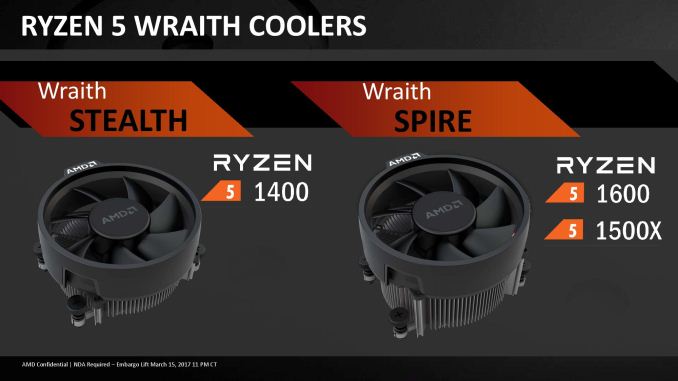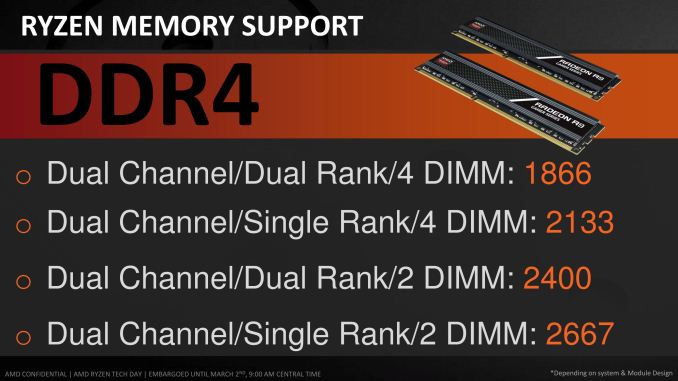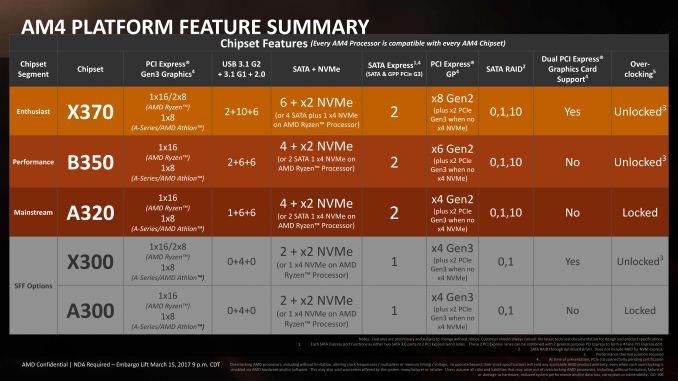The AMD Ryzen 5 1600X vs Core i5 Review: Twelve Threads vs Four at $250
by Ian Cutress on April 11, 2017 9:00 AM EST
Since the announcement of AMD’s mid-range offerings, it was clear that Ryzen 5 is going to have some major advantages over its direct price competition. For $250, the top Ryzen 5 1600X gives six cores and twelve threads of AMD’s latest microarchitecture. For the same price from Intel with a Core i5, you get four cores and no extra threads. Even though the Intel Core i5 based on Kaby Lake will have an instructions-per-clock advantage, it’s a hard hill to climb when the competition has 50% more cores and 200% more threads. In this review, we take the Ryzen 5 1600X and see if it smashes the market wide open.
Ryzen 3, Ryzen 5, Ryzen 7 (...Ryzen 9?)
Today marks the retail availability of AMD’s Ryzen 5 line of desktop processors. As the name suggests, Ryzen 5 sits between Ryzen 7, which was launched in March 2017, and Ryzen 3, to be launched in Q2 2017. The launch of Ryzen 7 last month was a return to the high-performance market for AMD, with its new x86 microarchitecture and core design built on GlobalFoundries 14nm process offering equivalent performance to Intel’s high-end desktop (HEDT) parts for under half-the-cost. Ryzen 5 is a step below that HEDT market, aiming more at mainstream users on more reasonable budgets.
One of the throwbacks to the Ryzen 7 launch for AMD was that the competition in that space was invariably overpriced to begin with – having had no competition for so many years, Intel was able to dictate the price and performance ratios without losing market share. While Ryzen 7 came out fighting in that market, ultimately it was up against a two-generation old CPU design from Intel, and not the latest, due to the way that Intel staggers its design cycle between mainstream and high-end processors. Ryzen 5, on the other hand, is coming out against processors that Intel has launched this year, on their leading design.
So while Ryzen 7 undercut the HEDT market by offering the same performance (in most cases) for half the price, Ryzen 5 can’t do the same. The midstream market is more price sensitive, and as a result AMD is launching Ryzen 5 at similar price points to Intel in this field. So while AMD can’t compete on price, it tackles the midstream market with more cores and more threads instead. Where Intel offers four cores, AMD offers six. Where Intel offers four threads, AMD offers twelve. This has implications for performance and power, which will be a part of this review.
(I'm joking about Ryzen 9 in the title to this section. No Ryzen 9 has been announced.)
The Ryzen Series
Without further ado, here is where the Ryzen families stand:
| AMD Ryzen 7 SKUs | |||||||
| Cores/ Threads |
Base/ Turbo |
XFR | L3 | TDP | Cost | Cooler | |
| Ryzen 7 1800X | 8/16 | 3.6/4.0 | +100 | 16 MB | 95 W | $499 | - |
| Ryzen 7 1700X | 8/16 | 3.4/3.8 | +100 | 16 MB | 95 W | $399 | - |
| Ryzen 7 1700 | 8/16 | 3.0/3.7 | +50 | 16 MB | 65 W | $329 | Spire RGB |
| AMD Ryzen 5 SKUs | |||||||
| Cores/ Threads |
Base/ Turbo |
XFR | L3 | TDP | Cost | Cooler | |
| Ryzen 5 1600X | 6/12 | 3.6/4.0 | +100 | 16 MB | 95 W | $249 | - |
| Ryzen 5 1600 | 6/12 | 3.2/3.6 | +100 | 16 MB | 65 W | $219 | Spire |
| Ryzen 5 1500X | 4/8 | 3.5/3.7 | +200 | 16 MB | 65 W | $189 | Spire |
| Ryzen 5 1400 | 4/8 | 3.2/3.4 | +50 | 8 MB | 65 W | $169 | Stealth |
Normally we see parts with with fewer cores having a higher clock frequency, however perhaps due to the voltage scaling of the design, we see a matched Ryzen 5 1600X in frequency to the Ryzen 7 1800X, but the rest of the Ryzen 5 family are offered at a lower TDP instead.
All the Ryzen 5 parts are unlocked, similar to the Ryzen 7 parts, and all four exhibit some movement in their ‘Extreme Frequency Range’ (XFR) mode, with the 1500X offering +200 MHz when there is sufficient cooling at hand.. AMD is going to offer some of these SKUs with their redesigned Wraith coolers, except the 1600X.
It is worth noting that the Wraith Spire for Ryzen 5 will not have RGB lighting, whereas the Wraith Spire for Ryzen 7 does use an RGB ring. OEMs will be able to use the higher-end Wraith Max stock cooler for their pre-built systems. AMD stated that at present, there are no plans to bring the Wraith coolers to retail as individual units, however they will keep track of how many users want them as individual items and regularly approach the issue internally.
To clarify some initial confusion, AMD has given me official TDP support numbers for the coolers. The entry level Wraith Stealth is 65W, the Wraith Spire is 65W for high-ambient conditions (AMD states this might be considered an '80W' design in low-ambient), and the Wraith Max is 95W for OEM builds using Ryzen 7 95W parts.
All the Ryzen 5 parts will support DDR4 ECC and non-ECC memory, and the memory support is the same as Ryzen 7, and will depend on how many modules and the types of modules being used. Recently companies like ADATA announced official support for AM4, as some users have found that there were memory growing pains when Ryzen 7 was launched.
Platform support for Ryzen 5, relating to PCIe lanes and chipset configurations, is identical to Ryzen 7. Each CPU offers sixteen PCIe 3.0 lanes for graphics, along with four lanes for a chipset and four lanes for storage. Chipsets can then offer up to eight PCIe 2.0 lanes which can bifurcated up to x4 (AMD GPUs can use chipset lanes for graphics as well, however at reduced bandwidth and additional latency).
Competition
The high-end Ryzen 5 1600X, at $249, is a shoe-in to compete against Intel’s i5-7600K at $242. Intel’s CPU is based on the Kaby Lake microarchitecture, and we’ve already shown in the Ryzen 7 review that by comparison Ryzen is more circa Broadwell, which is two generations behind. AMD won’t win much when it comes to single-threaded tests here, but the multi-threaded situation is where AMD shines.
| Comparison: Ryzen 5 1600X vs Core i5-7600K | ||
| AMD Ryzen 5 1600X |
Features | Intel Core i5-7600K |
| 6 / 12 | Cores/Threads | 4 / 4 |
| 3.6 / 4.0 GHz | Base/Turbo | 3.8 / 4.2 GHz |
| 16 | PCIe 3.0 Lanes | 16 |
| 16 MB | L3 Cache | 6 MB |
| 95 W | TDP | 91 W |
| $249 | Price (MSRP) | $242 |
Here we have twelve threads against four, at a 95W TDP compared to a 91W TDP (the 1600 is 65W, which looks better on paper). It is expected that for situations where a compute workload can scale across cores and threads that the AMD chip will wipe the floor with the competition. For more generic office workloads, it will interesting to see where the marks fall.
On the quad-core parts, there are several competitive points to choose from. The AMD Ryzen 5 1500X, at $189, sits near Intel’s Core i5-7500 at $192. This would be a shootout of a base quad-core in the Core i5 versus a quad-core with hyperthreading.
| Comparison: Ryzen 5 1500X vs Core i5-7500 | ||
| AMD Ryzen 5 1500X |
Features | Intel Core i5-7500 |
| 4 / 8 | Cores/Threads | 4 / 4 |
| 3.5 / 3.7 GHz | Base/Turbo | 3.4 / 3.8 GHz |
| 16 | PCIe 3.0 Lanes | 16 |
| 16 MB | L3 Cache | 6 MB |
| 65 W | TDP | 65 W |
| $189 | Price (MSRP) | $182 |
The reason why I didn’t pull out the Core i3-7350K there, at $168, is because the performance of the 7350K sits near the Pentium G4560, which is only $64 (and the subject of an upcoming review). That all being said, the $168 price of the i3-7350K matches up to the $169 price of the Ryzen 5 1400, although the 1400 has double the cores and double the threads of the 7350K.
Chipsets for Ryzen 5
The chipsets for AMD’s AM4 CPUs come in three main forms: the high-end X370 designed for premium Ryzen 7 systems and multi-GPU gaming (or multi-PCIe card workstations), mid-range B350 motherboards that still support overclocking but are more targeted at Ryzen 5 systems with a single graphics card, and the more budget range A320 which does not have overclocking and will be a fit in for Ryzen 3 later this year.
We are now at a point where the motherboard manufacturers are swimming in AMD motherboards, and distributors are building stock of various models. For Ryzen 5, AMD is pitching the B350 chipset based motherboards as a suitable solution, especially when compared to Intel’s B250 motherboards for Kaby Lake processors.
The B350 configuration matches that on the X370, save for a couple of PCIe lanes from the chipset and the focus on a single GPU.















254 Comments
View All Comments
happy medium - Tuesday, April 11, 2017 - link
this review could not have purposely made the Ryzen cpu's look any better.This site is ruined.
Drumsticks - Tuesday, April 11, 2017 - link
Care to elaborate?mmegibb - Tuesday, April 11, 2017 - link
This review is consistent with what I saw with the Ryzen 7 reviews on multiple sites. In multi-threaded tests, Ryzen beats Intel because, well, it has more threads. Single thread performance lags Intel. It's up to the user to figure out price/performance for their particular needs.I'm with Drumsticks, please elaborate. This kind of drive-by comment does nothing to advance the conversation.
Anandtech's suite of benchmarks is one of the best.
fanofanand - Tuesday, April 11, 2017 - link
Not only is Anandtech's benchmark suite the best, Ian is the best CPU reviewer in the business, and quite probably in the world. I would love to know what reviewer out there has a better understanding of uArches and has the experience of a professional overclocker who pushed every component to the limits. Ian's experience and background is ideal to review CPUs, and after having read the entire thing I didn't detect even a whiff of bias. Claims of bias towards AMD at Anandtech, that's a new one to me!ddriver - Tuesday, April 11, 2017 - link
Well, the JS benchmarks are pointless really.There is much to be demanded from the benches.
Too much emphasis put on games, do really 50% of the people use computers primarily for games?
Too little on practical tests, number crunching tests are with software barely anyone uses.
People need to see performance in premiere, after effects, cubase, pro tools, vray and similar.
Bias towards AMD however is hilarious, it is quite the opposite actually.
th3ron - Tuesday, April 11, 2017 - link
You seem to forget this is a review of $250 budget cpu's. No one's going to be running pro apps like the ones you listed on cpu's like these. The number crunching test are there for comparison with the more expensive cpu's. I don't think anyones ever bought a cpu based on its Winrar score.A lot of people will uses these cpu's for gaming so lots of gaming benchmarks make sense.
ddriver - Tuesday, April 11, 2017 - link
People who use winrar most likely do not make logical considerations, because if they did, they wouldn't be using garbage like winrar.It is not a budget product, it is mid-range. And it is perfectly capable of doing a good job in content creation and such at a great value. Most of the software used in this review can barely make use of 4 threads, making such tests 66.66% pointless. Most of the tests that can actually scale to utilize the chip are software barely anyone uses or isn't even practically useful to begin with. And contrary to your beliefs, that doesn't accurately translate into performance in software that people actually use.
wolfemane - Wednesday, April 12, 2017 - link
Get off your high horse. People with midrange CPUs aren't going to use pro software? Are you really serious? I know far more people on i5s and Older AMD CPU's who use premier and after effects. My wife and I use the Adobe suite regularly. Both our systems are running 2500k's. She is photographer and has been using mid-range components for just as long. I've been using premier, after effects, and Adobe media encoder longer than she's been using Photoshop. Adobe makes it pretty cheap to use their software. When they went to a monthly rate for their entire suite with free cloud based storage for $25 a month (I think it's a bit more expensive now) we jumped on it. The cloud storage alone is worth twice that.There's no way in hell I'd drop $500+ just on a processor and Intel has made it impossible for mid to low budget builders to afford 6+ cores. But with a pretty quick 6c/12t CPU, I'll be going with AMD for our next range of CPUs, which is coming soon. Sandy bridge is getting old. Just waiting for AM4 mITX.
calken99 - Wednesday, April 12, 2017 - link
Are you really telling me that the 70,000 i5 computers in the business that I work don't use any pro applications? That's just one small corporation. Businesses will dwarf the annual sales of CPUs in comparison to the domestic market.Meteor2 - Sunday, April 16, 2017 - link
I was trying to get some numbers on this. I think consumer computers outnumber corporate by a good two to one. Not sure the average age is that different either -- most places I've seen have been holding on to their PCs for years. Core 2s abound!